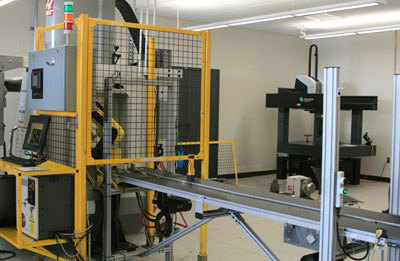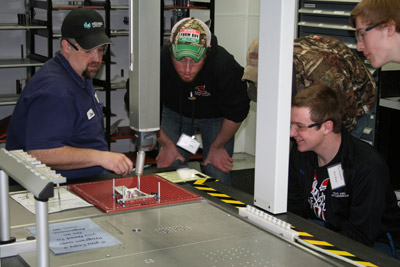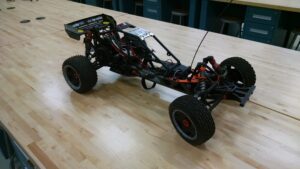The following article was published in The FABRICATOR magazine (July 2015)
By Dan Davis, Editor-in-Chief
Alexandra Industries, a producer and fabricator of aluminum extrusions in Alexandria, Minn., recognized the need to get involved in the local school district to boost the image of manufacturing in the eyes of students. But it didn’t just volunteer to send over speakers. It heavily influenced the curriculum at the new high school and donated new manufacturing technology.
“Where will I ever use this after I graduate?” It’s a student refrain that high school teachers hear on a consistent basis. Real-world examples can be offered as evidence of the necessity of these educational lessons, but sometimes the message is lost because the messenger and environment aren’t reflective of the world outside the high school campus.
That’s slowly changing in certain school districts across the U.S. as local companies become more involved in offering their employees as guest speakers and their facilities for field trips. These businesses realize that if they want a labor pool with certain skills and awareness of the local employment opportunities, they need to bring the real world to the school.
Alexandria Industries, Alexandria, Minn., has always been involved in an advisory role with local educational institutions in the north central part of the state. But when the local school district announced plans to build a new Alexandria Area High School, the manufacturer recognized a much bigger opportunity to boost the image of modern manufacturing in the eyes of young people.
The company took a lead in designing the manufacturing lab, developing the curriculum, and later providing engineers on-site to assist students while they worked on projects. Alexandria Industries also donated modern manufacturing equipment, so that students would be working on the latest machines, not an old piece of iron that was built in the early 20th century.
The 2014-2015 school year marked the opening of Alexandria Area High School, and the new Engineering, Manufacturing Technologies, and Natural Resources (EMTNR) Academy within the high school has shown promising results. Tom Ellison, an industrial technology teacher, believes the new equipment and interaction with real-world professionals have helped students realize what nearby manufacturing companies do and require from new hires.
“That’s a good refresher for them,” Ellison said. “They now can say, ‘This is why I’m doing this, why I’m learning what I’m learning.’ It’s directly applied to what’s happening in industry.”
Constructing a New Building
Alexandria is a town with a rich manufacturing legacy. About two hours west of the Twin Cities, the town has grown its industry thanks to generations of manufacturing talent from the surrounding area and the close proximity to one of the country’s most diversified local economies.
Alexandria Industries has grown over the last 50 years to become a major producer and fabricator of aluminum extrusions and a supplier of other manufacturing services, such as plastic injection and foam molding, mechanical and chemical finishing, and machining. Its parts end up in products used in the electronics, firearms, lighting, marine, medical, recreation, and renewable energy industries. The company has five locations in the U.S., with the headquarters/extrusion facility and the finishing operation in Alexandria. Fabricating operations take place at the main extrusion facility, which has about 385 employees.
Al Sholts, Alexandria Industries’ chief operating officer, knows the manufacturing reputation of the area quite well. After growing up in North Dakota, he came to work as a machinist for Alexandria Industries in 1977. While working, he took classes at Alexandria Technical and Community College, graduating with a degree in machine tool technology in 1979. Since then, he has worked all over the facility and had several managerial roles, such as machine shop manager and vice president of manufacturing. He assumed his current position in 2006.
Having been shaped by the local community college and working with it and the Alexandria School District over the years, Sholts said he knows that the town of Alexandria benefits from local residents and companies understanding the importance of a strong educational system, and everyone works to support it.
“There isn’t a lot of competitiveness among the industries, school district, and the schools when it comes to trying to have better educational opportunities for our kids,” Sholts said. “Everybody pulls together.”
An opportunity to do more than support education emerged three years ago when the community approved a referendum for a new Alexandria Area High School. Local industry had the opportunity to influence the educational process and the actual industrial technology program learning environment.
By the 2013-2014 school year, the school district had committed to implementing an “academy” approach to college preparation and career readiness. Incoming ninth-graders are part of a Freshman Academy, where they take English, math, science, and typical electives, but also have the opportunity to learn about the three different educational paths available to them in their ensuing years: a Business, Communication, and Entrepreneurship Academy; Health Sciences and Human Services Academy; and the EMTNR Academy. As students finish their freshman years, a ceremony takes place where each student chooses the academy experience they want to be a part of for the next three years.
The academy approach is being used in a much broader way in Nashville, Tenn., where Alexandria Area High School officials and advisers had the opportunity to tour schools. The academy style of education has the overarching goal of personalizing learning so that students are more engaged and, hopefully, better students. Two of the ways that this is accomplished is by a project-based, interdisciplinary teaching approach that aims to introduce the real world to the classroom and by interweaving personal in-class contributions and tour opportunities from local businesses.
Ellison had taught in a neighboring school district for 26 years, but had been coaching athletics in Alexandria since 1997. When the industrial technology teacher at Alexandria Area High School retired as the school was moving to this new educational model, school officials approached Ellison about joining their team. Ellison said he had no reason to leave his old job, but the new educational approach piqued his interest.
“At first I wasn’t interested because I had things going pretty well, but the more I talked to school district personnel [at Alexandria], the more excited I got about coming over and taking on the challenge of getting into a new building, changing the curriculum, and changing the daily schedule. It was exciting.
“The opportunity to be involved in a project like this with the support of our community manufacturers and local industry was important,” he added. “This was going to be pretty cool.”
Building a New Curriculum
The most visible contribution that Alexandria Industries, other nearby manufacturers, and the community made to the EMTNR Academy was equipment, worth about $300,000 altogether. Alexandria Industries donated an automated workcell, which includes a Haas VF-2 CNC machining center and a FANUC 200iB pick-and-place robot (see Figure 1). This equipment is easy to notice as well because the industrial lab is next to the general commons area, not buried at the back of the school as might be the case at a typical high school. A glass wall allows everyone to see just what the students are up to and how they are using the manufacturing equipment.
 |
Figure 1: Local manufacturers worked with Alexandria Area High School administrators and teachers to optimize the space allocated for the industrial technology labs and classrooms and to fill them with equipment. Alexandria Industries donated a RoboFlex pick-and-place robotic system and a Haas VF-2 CNC machining center. The robot has an integrated vision system and conveyor for part presentation and removal to and from the machining center. |
It doesn’t end there. The lab has a coordinate measuring machine (CMM), CNC plasma cutting table, five 3-D printers, a CNC wood router, 3-D modeling software, and a virtual welding machine, which has proven especially popular with students. Ellison said the virtual welder not only exposes the students to the skill needed to produce a quality weld, but also makes it fun as the students look forward to competing for the highest score.
The equipment is an exciting addition to the learning experience, Ellison said, but the biggest contribution might be the time that companies like Alexandria Industries make available for educators like himself.
“One thing that really helps me is that they have been open to me to come in and spend time in their manufacturing areas and learn what they do. That gives me a great foundation to bring back ideas into the classroom,” Ellison said. “For example, I know that they are running a CMM and what that does for them. We can apply that.”
How does that work within the EMTNR Academy? Ellison said, for example, a math class might visit the industrial lab to see how the CMM operates (see Figure 2). The students observe that the CMM can measure a part down to 10 thousandths of an inch. Then a question is posed: Can a factory make 50,000 of the scanned part within provided specifications? Statistical lessons are then applied to determine whether consistent quality can be maintained over the hypothetical production run or if the job specifications need to be widened to coincide with the results from the statistical models.
 |
Figure 2: Students visit Alexandria Industries to learn how a coordinate measuring machine works. The students measure a part that they designed and later use math principles to compare the real-world measurements to original design specifications. |
In other examples, typical industrial technology activities such as milling are tied into a physics lesson. Next year a geometry class centered on shop technologies will be offered to those that might find a traditional person-in-front-of-the-blackboard teaching method difficult to grasp.
“The other part [of this relationship with local industry] is having engineers, toolmakers, or machinists come into our classrooms and help our kids with their projects,” Ellison said.
“It’s a great partnership,” he added. “Kids can see the relevance of what they’re doing, and I think the engineers have fun coming in and talking to the kids.”
Sholts said he sees the same rewarding experiences.
“We allow our employees to spend a fair amount of time to be involved in this. I know there have been a lot of positive relationships built between the kids and our engineers as they work on these projects,” he said. “I know that there are a lot of smiling faces on both sides of it.”
Building on the Momentum
The 2014-2015 school year was the students’ first year in the new high school building, but the second year for the academy structure. The class of 2017 was the first formal Freshman Academy last year at the old building.
Ellison said that last year and this school year have given the teachers in the EMTNR Academy a good idea of how to incorporate the equipment into everyday lessons. They still have yet to fully dive into full operation of the machining center, and those types of opportunities lie ahead of them as they look to strengthen the educational experience for the roughly 300 students in the EMTNR program.
In the meantime, he is seeing positive results. Students who might otherwise be disinterested in school are finding excitement in the classroom, especially as it involves the manufacturing equipment.
He’s also seeing new interest in the school’s science, technology, engineering, and math (STEM) curriculum from the surrounding community. A recent STEM expo welcomed the community into the school, and Ellison said the lab was packed. Everyone was supposed to be out at 8 p.m., but people hung around the plasma cutting table for an extra hour. Also, Fridays are now reserved for tours; local groups and other educators want to see this new approach to education.
Ellison said that while the academy setup may look like skills training instead of a traditional, well-rounded educational offering, that’s not the case. It’s an educational approach that seeks to cover the core subjects and offer traditional electives, while reflecting real-world applications and opportunities (see Figure 3).
 |
Figure 3: As an example of mixing educational lessons with real-world settings, Alexandria Area High School students designed and built the front-end bumper bracket for a remote-control car using CAD software. Alexandria Industries provided the aluminum for the bracket, and the company’s toolmakers worked with the students to design and build the part using a CNC milling machine. Not only did the students learn about manufacturing and design, but they also had the opportunity to get a physics lesson intertwined with the making and running of the remote-control car. |
“We want kids to understand the opportunities in the engineering and manufacturing fields, so when they leave high school, they have a full idea of what’s out there,” Ellison said.
Sholts said that Alexandria Industries had no interest in setting up a re-education camp to create a future manufacturing workforce. It just wanted to enhance the students’ educational experiences and tie that in with real-world career paths.
“We want them to be exposed to opportunities and make a decision on what is best for them. There is a lot of counseling that happens, and they are aware of the job choices out there,” Sholts said. “But we’d like to create a passion that the kids need to have for their future career.”
Having said that, if graduates of the Alexandria Area High School EMTNR Academy choose to use their newfound skills at a manufacturing facility, Alexandria Industries might be interested. They, like other manufacturers in the region, are in expansion mode and are always interested in new manufacturing talent.
